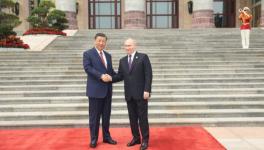Angelina Jolie's Mastectomy: Patenting Genes is Patenting a Discovery
Newsclick discusses with Satyajit Rath from the National Institute of Immunology the issue of Gene Patenting, in the background of Angelina Jolie’s mastectomy. The patenting of BRCA1 and BRCA2 genes by Myriad Genetics is a classic case of a discovery permitted to be patented. Rath says allowing a company to own genetic information, is under no circumstances healthy. The Myriad Genetics patents restrict public interests unreasonably. The patents effectively mean privatising the results of public funded research.
Transcript:
Prabir Purkayastha (PP): Hello and welcome to Newsclick. Today we have with us Dr. Satyajit Rath from National Institute of Immunology to discuss the issue of what has currently caught the world's attention -- Angelina Jolie's mastectomy, and the fact that Myriad Genetics really owns two genes in our body: BRCA1 and BRCA2, which was a cause of Angelina Jolie's step.
Satyajit, this has been in the Supreme Court of the Unites States for the last couple of years. Myriad genetics, today, is really sitting on what could be conceivably a big gold mine, and this case particularly, since it has hit the headlines, seems to have even boosted its stock price. How is it that a company owns two human genes in our body? Of course, only in United States as of now, and may be a few countries. How does- - did this happen?
Satyajit Rath (SR): The story goes back twenty five years. In the eighties, when the human genome was not sequenced. For a variety of diseases for which there seemed to be some reason to believe that there could be one or two genes responsible, there was an attempt to identify the genes. Cystic fibrosis was one of the early major triumphs in that sense, and I am calling it a triumph because it was very much in the public sector.
At the University of Utah, there were efforts to identify the genes that were causing familial breast cancer, which was not terribly common, but it clearly indicated that there was a genetic basis for breast cancer. And that's how BRCA1 was identified. As in- - as is the case with all of these instances without exception, BRCA1 was identified in the first place stepwise meaning that Prof. King, for example, identified that particular region on that particular chromosome contained the gene of interest. And then subsequently, other workers, including the people eventually leading the Myriad Genetics, sequenced the gene.
Now, what Myriad Genetics did was file patents and come up with diagnostics. This is an interesting niche area. It’s why Myriad Genetics portfolio, after 25 years, has not gone phenomenally beyond BRCA1, BRCA2 to cover the whole range, and you would expect that in 25 years there would have a bewildering array of genetic diagnostic tests that they hold the patents to. And that has not come to be the case. Their portfolio is relatively modest- - few genes. And that's because breast cancer of the BRCA1, BRCA2 driven kind does consist of about 10 per cent of all cases of breast cancer-- they are not all familiar, meaning BRCA1, BRCA2 mutations that are independent, not inherited, appear to be at stake in many cases.
And therefore, here is a situation where 10 per cent of breast cancer-- breast cancer is one of the leading causes of cancer, not simply in women, but one of the leading causes of cancer in general. And in that cancer, as many as 10 per cent of cases appear to have plausibly causative mutations in BRCA1 and BRCA2. So here's a situation where you can say as a diagnostic business ― we will tell you whether you are at risk. Now, the additional point here is that this is a breast cancer that becomes manifest only in late adult age. 10-year risks of developing breast cancer for 30-year olds are almost a fifth, if not a tenth of 10-year risks for 40-year olds or 50-year olds developing breast cancer. So you really are thinking about selling a test to adults who can pay for it in their thirties, in their forties.
PP: And still has a considerable amount of reduction, if you take, for instance, the kind of steps that Jolie did. But you know, here is the first question — really... really first question that appears to people’s mind — Myriad Genetics did not patent diagnostic tests. They, in fact, patented the two genes: BRCA1 and BRCA2. Now, how is it that genes that exist in your body, my body, other people’s bodies can therefore be considered to be patentable. Now, is that something that is usual in most countries? In fact, does India allow such patenting, and how did this happen in US?
SR: Well, India clearly does not-- as current law stands red - - does not allow such patenting. Many other countries read their patent law far more laxly than India has shown signs of doing so far, and therefore, do allow this kind of patenting. The Myriad Genetics patent was permitted. However, in the mid-90s, a group of individuals, who were deeply upset by Myriad Genetics’ broad ownership of BRCA1 and BRCA2, formed an association called the Association for Molecular Pathology, I think, and in association with the American Civil Liberties Union went to court, saying this was unreasonably broad and restrictive, and in general, that this was a natural phenomenon that can not be patented. That this wass nature getting patented which is forbidden by law. Judge Robert Sweet, I think, who heard the case- -
PP: 2009 in New York Federal Court.
SR: Right. And throughout Myriad Genetics patents lost out. Myriad Genetics went and appealed in 2010 or 2011, and the Appeals Court restored the patent, or most of them- - they... they actually struck down one or two claims. The Association and the CLU went to the Supreme Court. The Supreme Court accepted their arguments of the process and redirected the Appeals Court to examine the matter again. The Appeals Court upheld it. Remarkably, exactly one month before Angelina Jolie's article in the New York Times, this matter was re-argued as oral arguments...
PP: …in the US court.
SR: ...in the US court on the 15th of April. And it's very instructive to read the transcript. It tells us how very distinct patents as they are currently litigated have become from the original naïve, idealistic idea of a patent as an invention of a created artifact from the ingenuity of an individual to which the individual has rights. So now, in the Supreme Court, we have the spectacle of senior lawyers and Supreme Court justices debating the matter of — is CDNA recombinant DNA? Is CDNA, which simply means a DNA strand built complimentary to a- - to an RNA strand, which normally doesn't happen, but we can do it in laboratory-- Simply because we can do it in the laboratory, does it cease to be natural? It is at this level of- - it is not even hair-splitting, it's far beyond that.
PP: And angels dancing on the head of a needle.
SR: This is- - this is the ridiculous situation that we have come to. So Myriad Genetics is now claiming, from one point of view, that it's the CDNAs that they have (are) claiming rights to because CDNAs are not found in nature. But the information in the CDNA is exactly the same as the information in the original DNA, and the only realistic utility of DNA in nature is as information. So it's- - it's- - it's quite remarkable to see the kind of debates in the US Supreme Court last month, and put it together to the claims that Myriad Genetics is making, you are driven to the conclusion that the patent system, with regard not simply to this kind of biotechnology, but with regard, I dare say, to drugs and pharmaceuticals and diagnostics in general is terribly broken.
PP: Well, this is the argument, of course, the software industries have been giving for quite some time, and number of people have talked about the broken patent system in United States and so on. But coming back to the issue of Myriad Genetics, it's interesting that Myriad Genetics' claim in that sense of patenting a DNA strippet if you will, is different from the original “Diamond vs Chakrabarty,” which was a man-made bacteria, and the Supreme Court said anything man-made can be patented since it is an artificial life, therefore, now of course, that itself was very controversial —can life forms be patented? And that was the first life form patent that came up, in fact, again in United States. Then we had “Oncomouse” and so on. But life form patenting was one issue. Bad enough. But this is really the ability to cut out a snippet of a gene being, therefore, isolation virtually allowing it to be patented. This seems to be even more strange.
SR: It's actually worse than that. So consider the original Anand Chakraborty patenting of a micro-organism. That was a micro-organism that was pro-actively designed to carry out a certain function. This is, after all, not terribly different from coming up with a seed variety and asserting developer's right in some fashion on that seed variety because you have attempted to derive a seed variety with a certain set of properties. That's exactly what you have done using DNA technology with a micro- organism. You have designed it to carry out certain functions. So setting aside the issue of what patents vs grower's right and developer's rights mean, the fact that there is a certain element of intellectual input into generating these artifacts is, at least, plausible. Myriad Genetics case is not even that. All that they have done is sequenced. Now, even when they were sequencing it, there were half a dozen other laboratories who were in the race to sequence it. Everybody was using the same technology, the same methodology- - everybody knew what exactly they were doing. It's just that Myriad Genetics did it first. But they did not do it first as the result of a unique feat of intellectual conceptualisation, which after all is what we call is the inventive step.
PP: So the discovery vs invention...
SR: Exactly.
PP: ...which was the basis of the patenting system.
SR: Fundamentally, this is an example of precisely that.
PP: A discovery, not an invention.
SR: A discovery being permitted to be patented.
PP: Coming back to the other issue, which is the cost. Of course, If you have a monopoly, then you can charge whatever you want. 23,000 genes can be, today, sequenced in 1000 dollars. Myriad Genetics starts to charge 3,000 dollars to 4,000 dollars for the BRCA1, BRCA2 tests. Monopoly, profits, super profits.
SR: So- - at two separate levels this question would need to be addressed. At one level, of course, monopoly. No two ways about that. Even though as Myriad Genetics would point out, so let me point out that on their behalf, costs actually range from about 500 dollars to 4000 -- 5000 dollars, depending how comprehensive sequencing you want done. So there are different levels of the tests. Fair enough. It's still monumental.
But think about it this way — it's not simply the fact that they own the patent in the United States that allows them to price it at levels that are unaffordable for very many people. It certainly allows them to make profiteering levels of money. But consider India, which does not have patent protection for BRCA1, BRCA2 sequences. Yet, costs range- - if anecdotal information in the market place is any guide- - costs range for BRCA1, BRCA2 testing from anything between 5000 rupees to 50000 rupees. Clearly, at the high-end costs, huge profits are being made without patent protection. So the argument there is that here is a situation where who wants to know is a major question. And the people who want to know are usually the people who can afford to pay very substantial sums, and given India's population numbers, India's rich classes, no matter how small they are, how minuscule they are in percentage, are still substantial numbers sufficient to drive business strategies.
PP: Other issue which has also been flagged that Myriad Genetics has a complete lock-in on these two genes, particularly for research in the United States. All derivative research, if they use this gene, has to be again given back to Myriad Genetics. Myriad genetics essentially has stopped research in these genes, therefore, making further advances on the variety of issues, including the demography of the patients because originally BRCA1, BCRA2 was largely-- the demography was white women. Now, for other sections we don't know what the mutations-- what kind of mutations affect other demographies are not known. So do you think this is a healthy situation for the science?
SR: So-- one must admit that the situation is not as black and white as that. Again, for the record Myriad Genetics has been forthcoming in some selected situations by being gracious in permitting usage. Also, the fact is that sufficient testing has gone on even in United States for a fair amount of demographic information of some respectability to be accumulated and certainly if-- in India we have a fair amount of information of our own as well.
However, the fact remains that you are talking about a company owning genetic information. Under no circumstances can this be healthy. Now, you can turn around and say — if it's not unhealthy, how does it matter to you. It is unhealthy positively because it discourages people. It discourages competitors in the business world and it discourages large scale use in the public sector, which is the only place where public interest is properly, genuinely and immediately served. And those-- both those ways the Myriad Genetics patent is restricting public interest unreasonably.
PP: Do you think it's also prohibiting future innovation, or (does) such accumulation of profits help to drive biotechnology forward as Myriad Genetics and others are doing?
SR: As a matter of fact, a major argument that Myriad Genetics has made in the US Supreme Court, and that the Supreme Court Justices, at least some of them, appear from oral arguments to have been deeply impressed by is precisely this — that if they strike down this patent, would that discourage innovators? So the fact of the matter is that this was a discovery. The fact of the matter also is that these are discoveries that are overwhelmingly made by publicly funded research in the public sector.
So there isn't any question of whether striking this particular category of patents down. We are not talking about striking the patent regime down as far as the Supreme Court is concerned.
PP: Just talking about (striking) gene patenting down.
SR: Gene patenting down. It is clearly and manifestly not going to affect any discovery at all. Is it going to affect innovation? A reasonable way of asking that question is what is that innovation that Myriad Genetics has done, has made, has achieved in all these years of holding BRCA1, BRCA2 patents? If they had achieved innovations, then there would at least a case to argue that this innovation would not have happened in the absence of the patents. The fact of the matter is all what they have done is the sequence, sequence and sequence. They have used standard DNA diagnostic technologies to determine sequences of BRCA1 and BRCA2 and give reports to women. That's been their business model. No other innovation has occurred. As a matter of fact, all our mechanistic understanding how BRCA1 and BRCA2 cause the predilection to cancer has again, even over these past two decades, come from public sector research.
PP: Last question. This was in the public sector even the BRCA1, BRCA2 sequences in the Utah University. How come Myriad Genetics got a lock-on on this?
SR: So this is a matter of-- if you back to the early 80s in the United States, the Bahyl-Dole legislation which made it possible in the United States for the first time for publicly funded research to be patentable by the university professors, the university researchers who were publicly funded to carry it out. And that's exactly how Myriad Genetics were set up. It was set up by the people who were part of the publicly funded university effort to sequence BRCA1.
India, remember, has never had any prohibition against this individual patenting of publicly funded research. But, on the other hand, India has had a tradition of not doing so, or correctly of doing so and yet mandating non-exclusive licensing. This, over the past few years, has changed. It has changed, in one direction, by efforts to bring in a Bahy-Dole legislation-- somewhat besides the point though it may seem. But in the second instance, it has been changed by simply encouraging scientists to file patents and to generate revenue streams from them through exclusive licensing. As you can imagine, it's not a development that I am particularly in favour of because I don't think it serves the public interest. But perhaps more about that...
PP: Effectively privatising the results of publicly funded research. That's really where the Myriad Genetics-- these patents really came out of.
SR: Completely so.
PP: Thank you very much Satyajit. We will discuss once the supreme court gives it's judgement which is supposed to be this summer. Thank you very much.
Get the latest reports & analysis with people's perspective on Protests, movements & deep analytical videos, discussions of the current affairs in your Telegram app. Subscribe to NewsClick's Telegram channel & get Real-Time updates on stories, as they get published on our website.
























